You know that healthy water is very important for you and your family, but your not sure if the water that you have been drinking from your faucet is healthy or not. You want to get a reverse osmosis drinking water system to make your water better, but you are not even sure what reverse osmosis is and how it makes water better.
How Does Reverse Osmosis Work? Reverse osmosis works by forcing water through a semi-permeable membrane which allows filtered water to flow through, but rejects contaminants and rinses them away. Reverse osmosis greatly reduces the number of dissolved solids in water to make it safer to drink.
You have probably heard about the benefits of reverse osmosis from TV, the internet, and other people. Chances are, many of your friends already have a reverse osmosis drinking water system, and here’s why!
Just what is reverse osmosis, and what does it do to my water!
Osmosis is the addition of one entity to another. An example of osmosis would be adding a teaspoon of salt to a cup of water and stirring it around until the salt becomes entirely dissolved into the water.
As you might have already guessed, reverse osmosis is the process of taking that teaspoon of salt back out of the cup of water.
This is easier said than done with common filtering techniques, and a filter fine enough to remove dissolved solids like salt from water would clog quickly, making it not very practical for everyday use.
This is why reverse osmosis drinking water systems have become so popular for greatly reducing dissolved solids like salt in water.
The process of reverse osmosis is a way of filtering out very fine particles and dissolved solids from water.
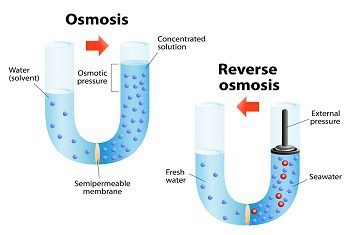
By rejecting impurities in the water and diverting them away to waste, a semi-permeable reverse osmosis membrane can filter out impurities from water without getting clogged like a regular filter.
The process of reverse osmosis was first discovered by a French clergyman named Jean-Antoine Nollet in 1748 using a pig bladder to reject impurities in the water while allowing less contaminated water to flow through.
But it wasn’t until the 1940’s that the process of reverse osmosis was considered for practical use in desalinating seawater. And not until 1965 was an effective synthetic reverse osmosis membrane developed to make the process available to the consumer. (source)
How much water pressure is needed for reverse osmosis?
The water pressure required to effectively filter out dissolved solids from water using the process of reverse osmosis depends on the quantity of water being filtered and the size of the reverse osmosis membrane being used.
However, an under sink reverse osmosis drinking water system that would be used in a residential household usually requires a minimum water pressure of 40 pounds per square inch (PSI).
Any less pressure will not provide enough pressure of the water against the reverse osmosis membrane to properly force the water through.
Most residential reverse osmosis drinking water systems work most efficiently at about 60 pounds per square inch.
This is because the mesh of the reverse osmosis membrane is able to maintain the ideal sized openings at this pressure to filter out dissolved solids from the water.
Water pressure exceeding 60 pounds per square inch can cause the mesh of the reverse osmosis membrane to tighten to the point where the water will not flow smoothly through the membrane, and the amount of wasted water will be more than necessary.
Does reverse osmosis work the same as normal filtering?
One of the primary benefits of the reverse osmosis process is that it does NOT work the same as a normal filter.
A regular filter removes unwanted impurities by capturing them within its surface area and pores until the filter is either cleaned or changed.
Once the impurities have been captured in the filter, they have nowhere to go, so the filter will have to be cleaned or replaced regularly.
The process of reverse osmosis filters out unwanted impurities and rinses them away so that the filtering membrane does not clog-up and have to be changed often.
But even though a reverse osmosis membrane does not need to be changed as often as a normal filter, the semi-permeable membrane does wear out over time and does need occasional replacement.
Do water filter pitchers use reverse osmosis?
Water filtering pitchers work very differently than a reverse osmosis filtering system.
While reverse osmosis works by filtering out impurities and then rinsing them away to waste, a water filtering pitchers primary filtering media is carbon which works great for particles that create odors or odd taste in water, but it is not intended for the removal of dissolved solids like sodium.
Because most reverse osmosis systems include a carbon filter stage, they will work as well as a water-filtering pitcher, and remove many other impurities including sodium.
Does reverse osmosis work on well water?
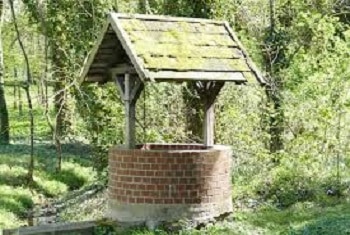
Absolutely! Reverse osmosis is most commonly used for well water because of the sodium that is naturally absorbed by the water that often comes from a well.
Also, reverse osmosis will work great on well water that may have odd tastes or odors in it because most reverse osmosis systems have one or more stages that use carbon specifically for that purpose.
In addition to sodium in well water, a reverse osmosis drinking water system works to remove many other chemicals and impurities like lead, pesticides, arsenic, and even bacteria.
If you are concerned with contaminants that may be in your well water, you can use a water test kit to test for many impurities that the process of reverse osmosis would be able to remove.
Does reverse osmosis work with municipal water?

Municipal water is great! It has been treated by a municipal water company to make sure that it is safe to drink. So you don’t need a reverse osmosis system if you have municipal water, right?
This is a very common misunderstanding about municipal water. Yes, your water has most likely been treated by chlorine to make your water drinkable, but your water can still contain a high level of salt and other dissolved solids, and of course, the chlorine.
A reverse osmosis system with a carbon pre-filter will work very well for removing the chlorine that has been added by your municipal water supplier.
Chlorine smells funny, and tastes terrible, so why would you want it in your drinking water?
Most reverse osmosis drinking water systems work with a carbon pre-filter just for this purpose. Because many people get their water from municipal water sources, they need reverse osmosis that will work to remove chlorine from their drinking water.
In addition to chlorine being very common in municipal water, the municipal water suppliers do nothing to reduce the amount of salt (sodium) in your drinking water.
Just because your water comes from a water treatment company to make your water safe to drink, does not mean that they have done anything to make your water healthy. (source)
Municipal water can have just as much, if not considerably more sodium in it than private well water. Because of this, a reverse osmosis drinking water system is just as important and will work very well, for any municipal water.
Where does the filtered water go?
Reverse osmosis works by allowing water to pass through a semi-permeable membrane, and then the filtered water is most commonly stored in a pressurized reserve tank to make it instantly available when desired.
The average reverse osmosis storage tank that comes with many popular reverse osmosis systems are referred to as 4-gallon tanks.
But because there is an air bladder inside of the tank to push the reverse osmosis water out of the tank, these 4-gallon tanks will normally only hold about two and a half gallons of filtered water.
Because of this, many people decide to swap the original tank that comes with the reverse osmosis system with a larger reverse osmosis storage tank.
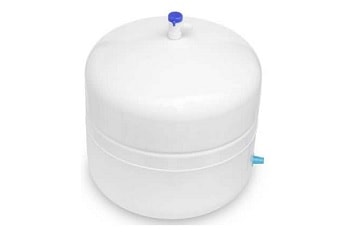
I have found several popular sizes of storage tanks that you can choose from. See my recommended reverse osmosis storage tanks to find which one would work best for you.
After the water has been stored for use, it is now ready to be used with the simple turn of the reverse osmosis faucet or refrigerator dispenser.
What happens to the impurities that reverse osmosis removes?
As the incoming water to be treated passes through the reverse osmosis membrane, some of the water filters through the membrane to be used later. But the impurities that the reverse osmosis membrane rejects are rinsed away to a drain.
Residential reverse osmosis will work most efficiently and use the least amount of water for rinsing away impurities when the incoming pressure is about 60 pounds per square inch (PSI), but most systems will work just fine with pressure as low as 40 PSI, or as high as 80 PSI.
What does reverse osmosis remove?
Reverse osmosis works by rejecting dissolved solids in water. This means that any dissolved solids in water that are too large to pass through the reverse osmosis membrane will be rejected, and rinsed away to waste.
The most common use for reverse osmosis is for the removal of dissolved salts in water. Salt is very common in water, and although many areas do not have levels of salt in the water that are considered to be unhealthy, it is often enough to make the water taste salty.
Reverse osmosis works very well at removing sodium from water, but it will also work very well at removing impurities like lead, chemicals, pesticides, arsenic, microbial cysts, fluoride, bacteria, and many, many more.
How much water can a residential reverse osmosis system produce?
The reason that most residential reverse osmosis systems come with a reserve storage tank is because of the way reverse osmosis works.
Because reverse osmosis works by only allowing some of the incoming water to pass through the reverse osmosis membrane for use, the speed at which reverse osmosis works is slower than the speed at which we would like to use it.
At this slow speed, if a residential reverse osmosis system were to work non-stop for 24 hours, it would produce between 50 and 100 gallons of filtered water per day.
I have chosen a few recommended reverse osmosis systems with different production rates. Although most small families will find that a 50 gallon per day system will work fine for them, some larger families find that 75 to 100 gallons per day systems work better for their needs.
What are the stages of a reverse osmosis system?
Pre-filtering:
Before your water reaches the actual reverse osmosis part of a reverse osmosis system, it should be pre-filtered to prevent large particles and sediment from getting lodged in the reverse osmosis membrane.
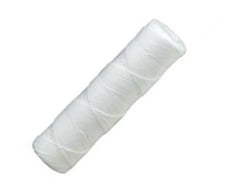
Sediment, dirt, iron, and other particles that may be in your water will not only clog the very fine openings of a reverse osmosis membrane but can even cause tearing of the membrane which can create holes to allow unwanted dissolved solids to pass through the membrane.
To prevent these particles from getting to the reverse osmosis membrane of your system, a sediment pre-filter is usually the first stage of most reverse osmosis systems.
Chemicals like chlorine can also damage a reverse osmosis membrane, and a carbon pre-filter should be used to prevent the chemicals from reaching the membrane.
Municipal water supplies are normally treated with a disinfectant like chlorine to make sure that the water will be safe to drink by the people using the water, so if you get your water from a municipal water supply, a reverse osmosis system with a carbon pre-filter is a must.
If you have well water, a carbon pre-filter may not be necessary for the removal of chemicals like chlorine, but it will also reduce impurities that may cause the water to have an odd taste or unpleasant odors.
This is why I usually recommend a reverse osmosis system with a carbon pre-filter and a carbon post-filter like the iSpring RCC7AK for municipal or well water.
Semi-permeable reverse osmosis membrane:
This is where the magic happens on a reverse osmosis system, but it really isn’t magic at all.
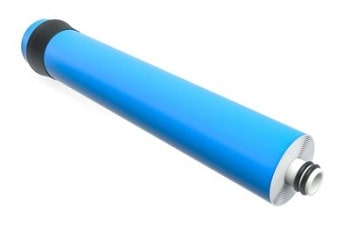
A reverse osmosis membrane is a fine mess filtering stage where your water goes into the membrane, and the tiny holes in the semi-permeable membrane allow water to pass through, but rejects impurities, and rinses them away.
Because the semi-permeable membrane rejects impurities instead of capturing them, the membrane does not fill with impurities and has to be changed frequently as a typical filter would.
Rather than try and explain it in boring detail, check out this quick video about how a semi-permeable membrane works.
Post-filtering:
After your water has gone through the reverse osmosis semi-permeable membrane, the number of dissolved solids in the water has been greatly reduced, but there can still be impurities in your water that may make it smell or taste bad.
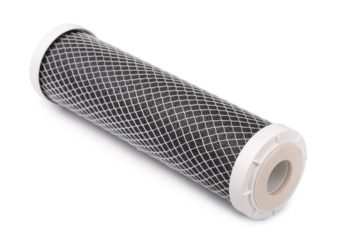
Most of the popular reverse osmosis systems on the market today will have a post-carbon filter to reduce impurities that cause poor taste or odor.
This is simply an additional filter that contains carbon which works very well at reducing levels of chemicals and particles in water that may produce odors or odd taste.
Re-mineralization:
This stage is not available on all reverse osmosis drinking water systems but you can get a separate re-mineralization cartridge that can be added to nearly any reverse osmosis system to re-introduce beneficial minerals that make reverse osmosis water have more flavor, raise the pH of the water.
Many reverse osmosis systems like the iSpring RCC7AK have a re-mineralization stage already included in the system.
Some other systems have this remineralization stage available, but the addition of this stage can be rather expensive on higher-priced reverse osmosis systems.
How does reverse osmosis benefit the average homeowner?
Whether or not you have a private well or if you receive your water from a municipal water supplier, your water will very likely have a significant amount of sodium and other dissolved solids in it.
Although, not all dissolved solids in water are considered to be harmful, minimizing the intake of sodium from drinking water is widely considered to be a good practice.
A reverse osmosis drinking water system in your home is a very economical way to take the existing water coming to your home, and greatly reducing the sodium content in it which will make it healthier to drink for you and your family.
Though many people think that buying bottled water is the only sure way to get water that is low in sodium, using a high-quality reverse osmosis drinking water system can often make your homes existing water better than average bottled water.
It all depends on how many total dissolved solids (T.D.S.) are in your water to start with. You can easily test the water of your home with a T.D.S. meter to give you an idea of how good your water could be when using a reverse osmosis drinking water system.
If your homes tap water has 100 total dissolved solids in a sample of water, a reverse osmosis drinking water system may produce drinking water with as little as about 2 total dissolved solids.
Obviously, a much better alternative to most bottled water that has 20, 30, 40 or even higher levels of total dissolved solids in it.
You also have the convenience of having your reverse osmosis water available right from your home and at the simple turn of a handle.
Are residential reverse osmosis drinking water systems expensive?
They can be! There are some companies out there that boast that their reverse osmosis systems are so much better, that they are worth a price tag of $1000.00, $1,600.00, and even as much as $3,000.00.
But remember that the process of reverse osmosis simply uses a semi-permeable membrane to greatly reduce the number of dissolved solids in water. Even if one system has more bells and whistles, the over-all process is virtually the same.
So why pay up to $3,000.00 for something that you can get for just a few hundred?
Well, the reality of it is that you don’t have to. I have chosen a few very well rated, and very popular reverse osmosis drinking water systems to suit any home needs.
Take a look at the different options to help you decide what reverse osmosis drinking water system is best for you and your family.

